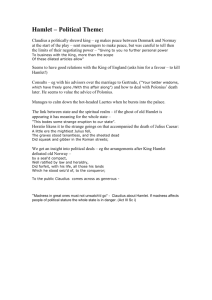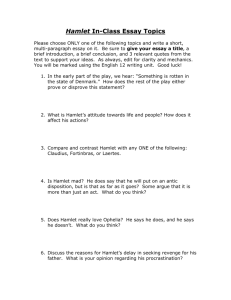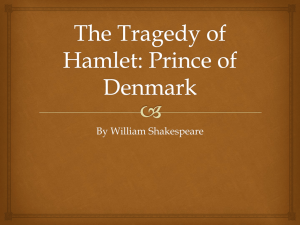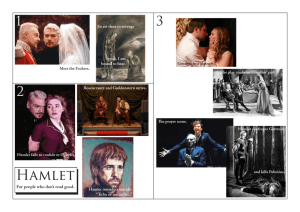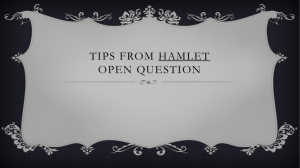Hamlet: Dramatic Structure & Literary Terms Presentation
advertisement
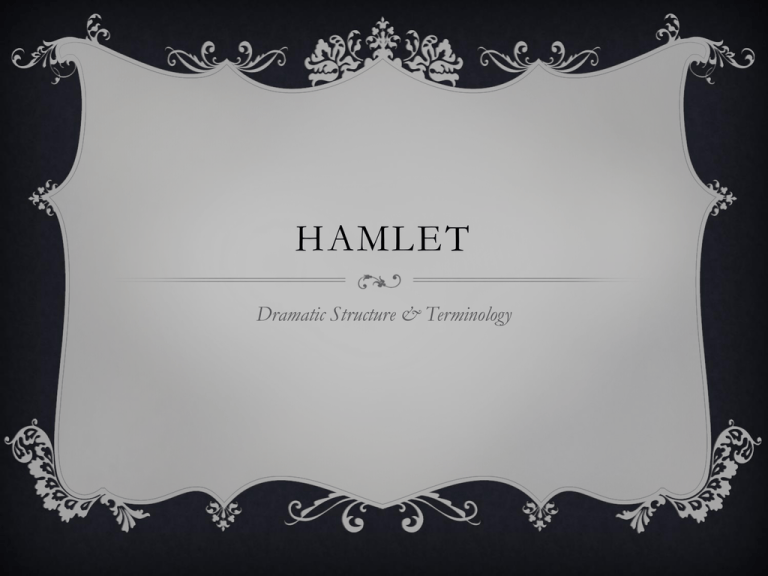
HAMLET Dramatic Structure & Terminology GUSTAV FREYTAG’S DRAMATIC STRUCTURE S H A K E S P E A R E ’ S T R AG E D I E S Gustav Freytag’s Dramatic Structure Act I – Exposition (setting, characters, mood developed, inciting incident) Act II – Rising action Act III – Climax (and Complication) Act IV – Falling Action (means to a solution) Act V – Catastrophe (Resolution) HAMLET LITERARY TERMS Foreshadowing Verbal irony • pun DRAMA terms Soliloquy Aside OTHER terms Foil character Allusion Double entendre Metaphor VERBAL IRONY The use of vocabulary to describe things in a way other than it seems. (similar to sarcasm) Clear as mud “I am too much in the son” DRAMATIC IRONY When the audience knows something that the players don’t know. Hamlet is playing at being crazy. FOIL CHARACTER DOUBLE ENTENDRE A word or phrase open to two interpretations, one of which is usually risqué or indecent. An expression or term open to more than one interpretation E X A M P L E S O F OX Y M O RO N Deafening silence Same difference Pretty ugly Act naturally Two words of contradictory meaning are brought together. Seriously funny EXAMPLES OF PARADOX Nobody goes to that restaurant, it’s too crowded. Save money by spending it. The beginning of the end. What a pity that youth must be wasted on the young. -George Bernard Shaw THE PLAY Write the name of your mother and father on a piece of paper Underneath write the name of an uncle on your father’s side (or if you don’t have one, choose a close male friend of the family) Now cross out your father Draw an arrow from your mother to the uncle This is Hamlet HAMLET The Prince of Denmark and our protagonist A reflective and thoughtful young man who has studied at the University of Wittenberg Hamlet is often indecisive and hesitant, but at other times prone to rash and impulsive acts About 17 years old CLAUDIUS The King of Denmark Hamlet’s uncle, and the play’s antagonist Claudius is shrewd and manipulating. Claudius assumes control of the kingdom at the death of his brother. He also convinces his brother’s wife to marry him, probably to consolidate his control in Denmark. GERTRUDE Queen of Denmark Hamlet’s mother, recently married to Claudius The question of why Gertrude marries so soon after her husband’s death one of the most important questions in the play. What do you think? KING HAMLET Before the play begins, King Hamlet dies while sleeping in his garden He appears in the play as a ghost. Is he the ghost of Prince Hamlet’s father, a demon that has taken the late king’s form to wreak havoc in the kingdom, or a figment of Prince Hamlet’s diseased mind? HORATIO Prince Hamlet’s close friend Studied with the Prince at the University in Wittenberg Horatio is loyal and helpful to Hamlet throughout the play POLONIUS Lord Chamberlain of Claudius’ court. The King’s principle advisor A pompous, conniving old man Polonius appears to have risen to power by skillful manipulation, however, he suffers from overconfidence. Hamlet enjoys exposing him as a fool. Father of Laertes and Ophelia OPHELIA Polonius’ daughter and a beautiful young woman. Prince Hamlet’s love interest, but their relationship is a secret at the start of the play. She is not of royal birth and is not deemed a suitable match for the Prince. LAERTES Polonius’ son, Ophelia’s brother A young man who spends much of the play away from court enjoying the pleasures of France Passionate and quick to action, Laertes is clearly a foil for the reflective Hamlet. Laertes is the greatest swordsman in all of Denmark. YOUNG FORTINBRAS Another foil of Prince Hamlet The Prince of Norway, whose father (also named Fortinbras) was killed by King Hamlet when Prince Fortinbras was a child.. Now that King Hamlet has died, Fortinbras longs to avenge his father’s death and regain the land his father lost in battle. ROSENCRANTZ & GUILDENSTERN Two slightly bumbling courtiers, former friends of Hamlet from Wittenberg, who are summoned by Claudius and Gertrude to discover the cause of Hamlet’s strange behavior

